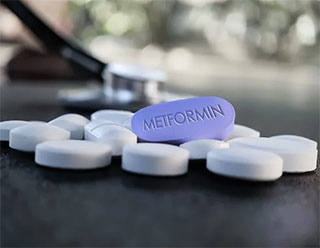Metformin for Alopecia
Metformin for Alopecia

What is Metformin?
Metformin is a medicine mainly used to treat type 2 diabetes mellitus (T2DM) and gestational diabetes as well as prevent T2DM in those who are at a high risk of developing the disease. It is usually prescribed for individuals who have T2DM or gestational DM but in some cases can be used in individuals with polycystic ovary syndrome (PCOS).
How does Metformin work?
Metformin is an antiglycemic agent that improves glucose tolerance in patients with T2DM, typically in oral formulation. It acts on the glycogen synthase and stimulates the intracellular synthesis of glycogen. On a smaller level metformin can inhibit the mitochondrial respiratory chain in the liver leading to the activation of AMPK. It lowers not only basal and postprandial plasma glucose but improves insulin sensitivity by decreasing hepatic glucose production and intestinal absorption. It can also improve insulin sensitivity by increasing peripheral glucose uptake and utilization.
What is Central Centrifugal Cicatricial Alopecia (CCCA)?
Central Centrifugal Cicatricial Alopecia or CCCA is a common condition that mostly affects women of African descent that can run in families. It is a form of scarring alopecia that presents as patches of permanent hair loss on the crown of the scalp and spreads centrifugally, moving away from the center outward. The cause of CCCA is not clear. There are many different theories on why CCCA occurs, but current evidence suggests that it is multifactorial. It could be due to infections, autoimmune diseases, genetic factors, or just an idiopathic disease.
Treatment Options for Central Centrifugal Cicatricial Alopecia (CCCA)
Treatment for CCCA prioritizes hair regrowth and preventing or halting the progression of the disease. It is important to note that hairs will not regrow from permanently damaged hair follicles.
The first-line of treatment for CCCA is the use of anti-inflammatory agents such as topical steroids or intralesional injection of triamcinolone. Followed by antibiotics, both topical and oral formulations, and other systemic anti-inflammatory treatments like mycophenolate mofetil, hydroxychloroquine, and cyclosporine.
It is also important to stress the importance that minimal hair grooming is recommended. Although there is not much evidence on the effectiveness, it is recommended that haircare practices be modified and excessive traction of hairs be avoided.
How can metformin help with CCCA?
Metformin mainly has its effect through AMPK activation and has a range of downstream hormonal effects that include improvement of insulin sensitivity through increased glucose uptake and reduction of circulating lipids and androgens. Androgens are known to promote conversion of terminal hairs to vellus hairs, or “peach fuzz”. That is why it is thought that metformin can help grow hair; medicines that reduce circulating androgens, such as metformin, could alter the progression of androgenetic alopecia.
Dosing
The typical dosing for metformin when used as an antidiabetic agent ranges from 500 mg to 1000 mg with a maximum daily dose of 2,550 mg/day. When it is dosed for topical application as a treatment option for CCCA, the proposed dose was metformin 10% compounded in lipoderm cream. This dose was studied in a case study conducted by and chosen based on pharmacist recommendations with the goal to minimize systemic absorption while still maintaining its therapeutic effects.
Ways to get topical Metformin?
Metformin is only commercially available in tablet form, to get topical metformin, it must be acquired only through compounding specialty pharmacies with a valid script from a prescriber.
Possible Topical Formulations
Metformin can be compounded into various formulations, such as:
- Creams
- Lotions
- Gels
- Ointments
References:
- Ludmann P. Hair loss types: central centrifugal cicatricial alopecia overview. [Updated 2022 Mar 14]. In: American Academy of Dermatology [Internet]. Rosemont (IL): AAD Publishing; 2022 Mar -. Available from: https://www.aad.org/public/diseases/hair-loss/types/ccca
- (Metformin). In: Merative Micromedex® DRUGDEX® (electronic version). Merative Healthcare Solutions/EBSCO Information Services, Greenwood Village, Colorado; Cambridge, Massachusetts, USA. Available at: https://www-dynamed-com.ezproxy.sju.edu (cited: January 11, 2024)
- Araoye EF, Thomas JAL, Aguh CU. Hair regrowth in 2 patients with recalcitrant central centrifugal cicatricial alopecia after use of topical metformin. JAAD Case Rep. 2020 Jan 22;6(2):106-108. doi: 10.1016/j.jdcr.2019.12.008. PMID: 32016152; PMCID: PMC6992882.
- Gabros S, Masood S. Central Centrifugal Cicatricial Alopecia. [Updated 2022 May 8]. In: StatPearls [Internet]. Treasure Island (FL): StatPearls Publishing; 2023 Jan-. Available from: https://www-ncbi-nlm-nih-gov.ezproxy.sju.edu/books/NBK559187/
- Kokhabi P, Dadkhahfar S, Robati RM. Topical metformin as a novel therapy for alopecia areata due to its immunologic effects. Med Hyp. 2023 Oct;179
- https://www-sciencedirect-com.ezproxy.sju.edu/science/article/pii/S0306987723001512
- Bubna AK. Metformin - For the dermatologist. Indian J Pharmacol. 2016 Jan-Feb;48(1):4-10. doi: 10.4103/0253-7613.174388. PMID: 26997714; PMCID: PMC4778205.
- DynaMed. Hair Loss in Adults - Approach to the Patient. EBSCO Information Services. Accessed January 11, 2024.
- Rena G, Hardie DG, Pearson ER. The mechanisms of action of metformin. Diabetologia. 2017 Sep;60(9):1577-1585. doi: 10.1007/s00125-017-4342-z. Epub 2017 Aug 3. PMID: 28776086; PMCID: PMC5552828.

Comments